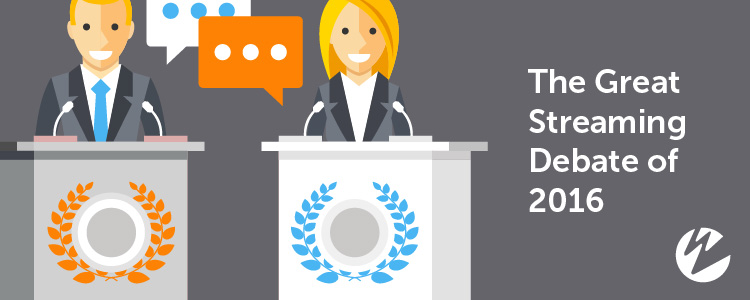The Great Streaming Debate of 2016

In 2000, American politics were turned upside down with the invention of Internet advertising and online fundraising. For the first time, American citizens were exposed to online coverage of the election, and candidates were able to reach new audiences for their respective campaign efforts.
The growth of online audiences and political action has hit a tipping point in the last two US election cycles, with President Obama’s social media team leveraging major online mobilization to blanket Facebook, Twitter, Instagram, and other social media networks. Libertarian candidate Gary Johnson has even described social media as his campaign headquarters in this election.
But this year marks another shift in the online media landscape. No longer are social networks only a place for citizen discourse and advocacy; now they're also where the debates can be viewed and dissected in real time. ABC and Bloomberg are live-streaming to Facebook and Twitter respectively—providing an alternative to traditional major broadcast-network delivery. This presents an interesting challenge and opportunity for the American political machines.
Despite being broadcast on all major TV networks and cable news stations, the debates will be able to “go to the audiences” instead of hoping that people tune in to the network channels. That’s because Facebook, Twitter, YouTube, and other social channels already have an audience of subscribers that is significantly larger than the TV and cable audience, and this new streaming approach reaches the subscribers, mobile viewers, and cord-cutters who may not have access to a broadcast feed. But inherently there are challenges in delivering streaming content via these various online outlets.
Will It Scale?
The Reagan vs. Carter debates of 1980 hold the record of more than 80 million households tuning in, and that was before cable news networks. In 2012 almost 70 million people tuned in across major networks and cable. However, this year brings a new audience—the social media viewer—which saw a lot of success during both the Republican and Democratic national convention live streams, topping 215K and 250K respective concurrent viewers. With the new audiences, experts estimate this year’s debate will be the most watched in US history, with potentially more than 100 million viewers, or just about a third of US citizens, tuning in to see tonight’s debate.
While the network numbers alone are staggering, the estimated number of social media viewers presents a scalability challenge. The content providers' streaming infrastructures will be under a lot of stress. ABC, Bloomberg, and others will need to be sure that a potentially global audience can follow along on their choice of viewing devices without buffering, stuttering, low visual quality, or huge amounts of latency.
You Can’t Set It and Forget It.
Bandwidth is another important factor. Streaming delivery will need to dynamically adjust to each viewer to accommodate people tuning in on a broad variety of laptops, tablets, and other mobile devices, all with competing local bandwidth constraints and delivery roadblocks. With the masses of people expected to access the streams via mobile or portable devices, ISP networks will feel an increased strain from the streaming demand. This may result in lower-quality streams, higher latency (delay from when the candidates speak to when a viewer hears them), or frequent stream-quality shifts as traffic becomes congested in the “last mile,” that part of the network from the ISP to the viewer.
But adjusting for mobile devices, and iOS devices in particular, also means that streaming providers have to account for HLS workflows, which typically have a minimum of 30 seconds of latency. Ideally, the streams will match the broadcast latency (~6 seconds) if they expect audience participation and commentary to remain in sync with the TV and cable broadcasts.
A lot of Thursday Night Football viewers have mentioned this when critiquing Twitter’s streams. In some cases, viewers on mobile devices experienced almost two minutes of latency before seeing the action. This left some people stuck waiting for the plays to arrive on their device while they read a constant flow of comments from people watching the CBS broadcast on TV. “What a catch,” one broadcast viewer’s tweet says, while the guy streaming via Twitter is still waiting to see the play start, yet alone unfold.
There’s no debating the fact that this year’s presidential showdown will be full of fireworks and bravado, as two of the most polarizing candidates in memory take the stage. The question is, will it be a streaming success or a technical gaffe?




